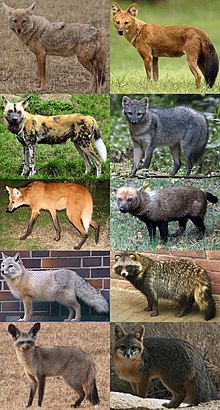Canidae
| Canids Temporal range: 39.75–0 Ma Late Eocene-Holocene |
|
|---|---|
 |
|
| Major extant canid genera left-to-right, top-to-bottom: Canis, Cuon, Lycaon, Cerdocyon, Chrysocyon, Speothos, Vulpes, Nyctereutes, and Urocyon | |
| Scientific classification | |
| Kingdom: | Animalia |
| Phylum: | Chordata |
| Class: | Mammalia |
| Order: | Carnivora |
| Suborder: | Caniformia |
| Family: |
Canidae G. Fischer de Waldheim, 1817 |
| Genera and species | |
|
See text |
|
See text
The biological family Canidae /ˈkænᵻdiː/ is a lineage of carnivorans that includes domestic dogs, wolves, foxes, jackals, dingoes, and many other extant and extinct dog-like mammals. A member of this family is called a canid (/ˈkænᵻd/, /ˈkeɪnᵻd/).
The cat-like feliforms and dog-like caniforms emerged within the Carnivoramorpha 43 million years before present. The caniforms included the fox-like genus whose various species existed from 34 million years before present before branching 11.9 million YBP into Vulpini (foxes) and Canini (canines).
Canids are found on all continents except Antarctica, having arrived independently or accompanied human beings over extended periods of time. Canids vary in size from the 2-m-long (6 ft 7 in) gray wolf to the 24-cm-long (9.4 in) fennec fox. The body forms of canids are similar, typically having long muzzles, upright ears, teeth adapted for cracking bones and slicing flesh, long legs, and bushy tails. They are mostly social animals, living together in family units or small groups and behaving cooperatively. Typically, only the dominant pair in a group breeds, and a litter of young is reared annually in an underground den. Canids communicate by scent signals and by vocalizations. They are very intelligent. One canid, the domestic dog, long ago entered into a partnership with humans and today remains one of the most widely kept domestic animals.
...
Wikipedia
